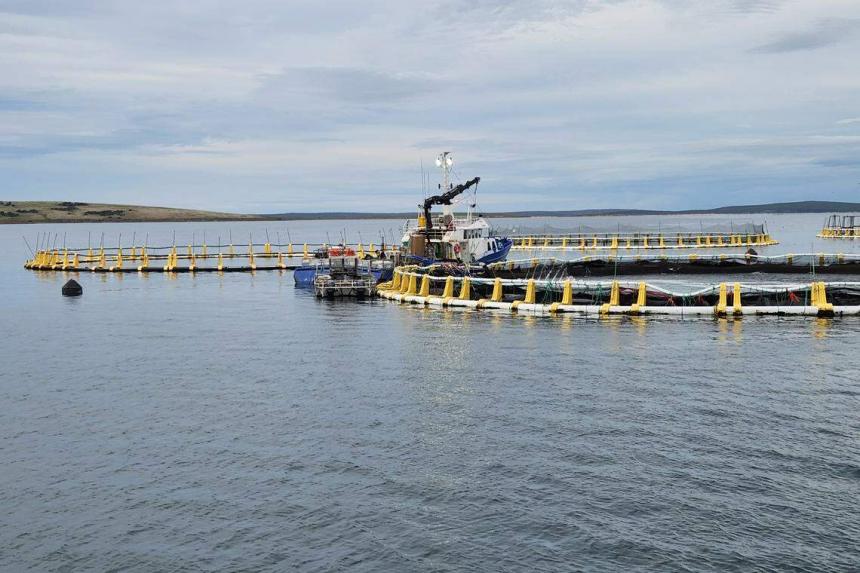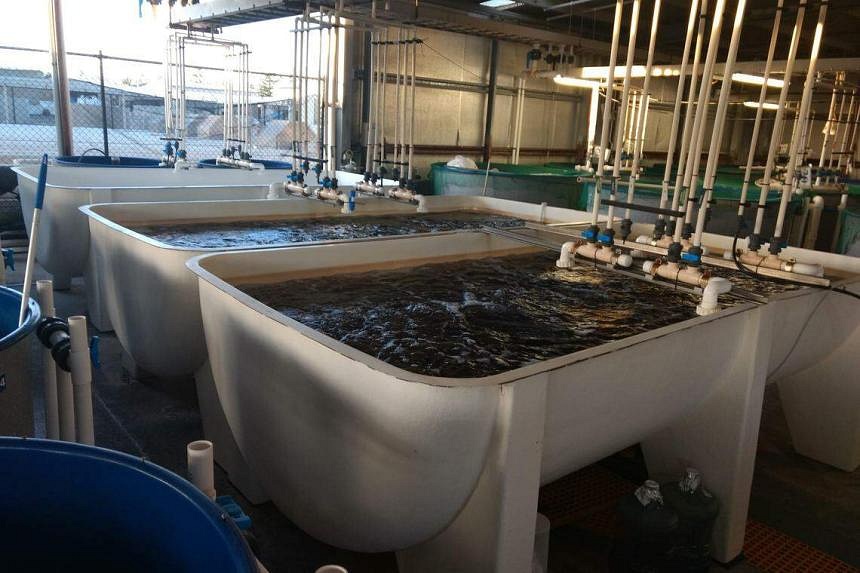SINGAPORE – Next to the deep-sea cages holding farmed yellowtail kingfish, a small pod of dolphins splashes out of the Spencer Gulf waters. On a nearby rocky islet, Australian sea lions and seals lazily roll about and vocalise, much to the glee of observers on a boat.
The nearly 10 large sea cages are run by Clean Seas Seafood, the world’s largest yellowtail kingfish supplier outside of Japan, producing about 3,500 tonnes a year, which is nearly 80 per cent of Singapore’s local seafood production in 2022.
The vast Spencer Gulf, off the coast of Australia’s seafood capital Port Lincoln in South Australia, paints a picture of how successful aquaculture can coexist with marine animals, as long as care is taken to protect the environment.
While sea lions and other animals could prey on the kingfish, high tensile nets limit the predators’ access to the farmed fishes. The company also keeps an eye on nearby seagrass meadows.
“The health of the seagrass in the places that we farm is the most important metric in terms of understanding the impact of our farming,” Mr Robert Gratton, chief executive of Clean Seas, said to the observers on the boat.
They comprised people from the Singapore Food Agency (SFA) and the Ministry of Sustainability and the Environment, as well as fish farmers, academics and the media from the Republic.
Led by Senior Minister of State for Sustainability and the Environment Koh Poh Koon, the delegation visited southern and western Australia in late June to learn more about the best practices in aquaculture to boost Singapore’s food security.
The Republic’s aquaculture sector is still nascent, accounting for 7.6 per cent of seafood consumed in the country in 2022.

In Singapore, most of the sea-based fish farms are along the Johor Strait, which tends to be rich in nutrients and lower in oxygen. While the authorities have been looking to expand aquaculture to the south in the Singapore Strait, nature groups are concerned that farming will impact the richer marine life there, including pristine coral reefs and vulnerable species like giant clams.
In Australia, many resources and investments are channelled into rearing young fish the correct way, to prevent avoidable diseases and deaths.
Clean Seas strives to give its yellowtail kingfish the best start in life. At 40g in size, the juveniles are taken from their nursery on land and whisked to the deep-sea cages by helicopter. The cylindrical storage is lowered to the sea and opened to gently release the fingerlings.
It takes just 10 minutes to take the fish to the sea via helicopter. The process is less disruptive for the juveniles and logistically smoother compared with using lorries and ships, said Mr Gratton.

Mr Steve Nel, aquaculture manager at Western Australia’s Department of Primary Industries and Regional Development (DPIRD), said the most difficult and technologically complex part of rearing marine fish is the hatchery stage. This is where governments can step in, he said.
“Getting the brood stock to spawn, getting viable eggs, growing those eggs to the very small larval stages and up to a fish of about 5g which can then be grown out more easily... Hatcheries can be quite expensive to develop and they also need to be staffed by (experts),” he added.

Due to the high cost of establishing hatcheries, small aquaculture sectors will be reluctant to take that level of risk and investment.
It is wiser for the government to set up the facilities and supply smaller farms with fish fry and juveniles, while those firms focus on optimising their farming methods, said Mr Mike Harrison, aquaculture project manager at DPIRD’s Marine Finfish Hatchery in Fremantle, Western Australia.
The hatchery, opened in 1993, supplies barramundi, or Asian sea bass, juveniles to commercial farms and conducts research related to the breeding, nutrition and disease-resistance of yellowtail kingfish.

Among the 130 or so land- and sea-based seafood farms in Singapore, only a handful have their own hatcheries and nurseries. Most tend to import newly hatched fish.
In November 2022, SFA entered an agreement with Belgium-headquartered Inve Aquaculture to set up a hatchery technology centre at the agency’s Marine Aquaculture Centre on St John’s Island.
A perennial pain point in sea-based aquaculture is nutrient pollution, mainly caused by uneaten fish feed and fish waste. Water quality can affect the amount of fish that can be produced in an aquaculture zone, and excess nutrients can be harmful to marine life, seagrass and corals.
In Australia, the Singapore team was introduced to a natural way to clean the waters near fish farms – by growing seaweed.
Seaweed feeds on nutrients such as nitrates and phosphorus to grow. The waters off South Australia are home to 1,500 seaweed species, and the state’s Department of Primary Industries and Regions (Pirsa) has received more than 50 licences for seaweed cultivation to date.
The seaweed is also harvested to be made into higher value products.
A Port Lincoln tuna company has worked with Pirsa’s research arm to make liquid fertiliser from red seaweed that naturally grows on mooring anchor ropes of aquaculture cages.
The research arm, the South Australian Research and Development Institute (Sardi), later extracts a valuable protein pigment from the red seaweed, which can be used in the food industry. With its colour, the red pigment can be used as “vegan blood” for plant-based steaks, said Dr Sasi Nayar, sub-programme leader for the institute’s Algal Production Group.
He added that 1kg of the pigment, called phycoerythrin, can fetch US$250,000 (S$330,400).

Another popular seaweed, Asparagopsis, is known to reduce cattle’s methane emissions by up to 90 per cent when fed to cows. Methane is a potent greenhouse gas contributing to global warming, and Australia is one of the world’s top beef exporters.
With seaweed that can absorb nutrients released by farming, Dr Nayar added that there is scope to treat nutrients like carbon credits. This means that if a less pollutive aquaculture firm uses seaweed, for example, that feeds on nutrients in the water, extra nutrients absorbed can be sold as credits to large farms that pollute more.
“Monetising excess credits provides a further incentive to aquaculture companies to reduce their nutrient footprint,” said Dr Nayar, who is also the programme leader for aquaculture at Sardi. At the moment, there are no nutrient credit mechanisms.
The promises of seaweed excited the Singapore farmers on the trip since cleaning the waters could allow them to keep more fish and enjoy higher yields.
Asparagopsis has been spotted in Singapore’s southern waters. Dr Nayar, who did his doctorate here, identified other species of seaweed such as Gracilaria, a succulent red type that is commonly found on many shores here and used to make agar-agar.

Mr Malcolm Ong, one of the farmers on the trip, is keen to do some seaweed experiments at his farm to test its viability. He is chief executive of The Fish Farmer, which runs four offshore farms here that are mostly operated with solar power.
National University of Singapore marine biologist Toh Tai Chong, who was one of the academics on the trip, said: “We do have many species of seaweed that could have potential use in nutrient absorption. We haven’t explored this extensively and there is potential to examine it.”
Other scientists on the trip wondered if seaweed cultivation could compete with other habitats such as coral reefs.
Mr Ken Cheong, chief executive of the Singapore Agro-Food Enterprises Federation, said: “Seaweed seems to be an annoyance when we go to the beach, but it gives hope. The industry in Australia came forward to solve a regulatory and environment issue (on nutrient effluent). They were really thinking about how to scrub the waters.”


